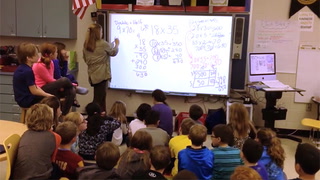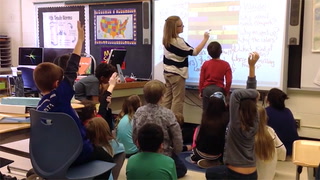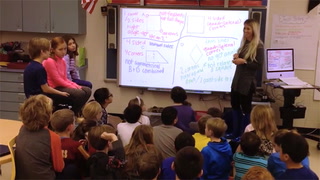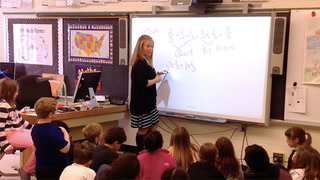Series Math Routines with Kristin Gray: Fourth Grade: True or False Equation Routine: Fourth Grade
Math.4.NF.B.3b
| Common core State Standards
- Math: Math
- 4: Grade 4
- NF: Number & Operations--Fractions
- B: Build fractions from unit fractions
-
3b:
Understand a fraction a/b with a > 1 as a sum of fractions 1/b.
a. Understand addition and subtraction of fractions as joining and separating parts referring to the same whole.
b. Decompose a fraction into a sum of fractions with the same denominator in more than one way, recording each decomposition by an equation. Justify decompositions, e.g., by using a visual fraction model. Examples: 3/8 = 1/8 + 1/8 + 1/8 ; 3/8 = 1/8 + 2/8 ; 2 1/8 = 1 + 1 + 1/8 = 8/8 + 8/8 + 1/8.
c. Add and subtract mixed numbers with like denominators, e.g., by replacing each mixed number with an equivalent fraction, and/or by using properties of operations and the relationship between addition and subtraction.
<br />
d. Solve word problems involving addition and subtraction of fractions referring to the same whole and having like denominators, e.g., by using visual fraction models and equations to represent the problem.
Grade 4 expectations in this domain are limited to fractions with denominators 2, 3, 4, 5, 6, 8, 10, 12, 100.
Math.4.NF.B.4a
| Common core State Standards
- Math: Math
- 4: Grade 4
- NF: Number & Operations--Fractions
- B: Build fractions from unit fractions
-
4a:
Apply and extend previous understandings of multiplication to multiply a fraction by a whole number.
a. Understand a fraction a/b as a multiple of 1/b. For example, use a visual fraction model to represent 5/4 as the product 5 × (1/4), recording the conclusion by the equation 5/4 = 5 × (1/4).
b. Understand a multiple of a/b as a multiple of 1/b, and use this understanding to multiply a fraction by a whole number. For example, use a visual fraction model to express 3 × (2/5) as 6 × (1/5), recognizing this product as 6/5. (In general, n × (a/b) = (n × a)/b.)
c. Solve word problems involving multiplication of a fraction by a whole number, e.g., by using visual fraction models and equations to represent the problem. For example, if each person at a party will eat 3/8 of a pound of roast beef, and there will be 5 people at the party, how many pounds of roast beef will be needed? Between what two whole numbers does your answer lie?
<br />
Grade 4 expectations in this domain are limited to fractions with denominators 2, 3, 4, 5, 6, 8, 10, 12, 100.
Math.4.NF.B.4b
Common core State Standards
- Math: Math
- 4: Grade 4
- NF: Number & Operations--Fractions
- B: Build fractions from unit fractions
-
4b:
Apply and extend previous understandings of multiplication to multiply a fraction by a whole number.
a. Understand a fraction a/b as a multiple of 1/b. For example, use a visual fraction model to represent 5/4 as the product 5 × (1/4), recording the conclusion by the equation 5/4 = 5 × (1/4).
b. Understand a multiple of a/b as a multiple of 1/b, and use this understanding to multiply a fraction by a whole number. For example, use a visual fraction model to express 3 × (2/5) as 6 × (1/5), recognizing this product as 6/5. (In general, n × (a/b) = (n × a)/b.)
c. Solve word problems involving multiplication of a fraction by a whole number, e.g., by using visual fraction models and equations to represent the problem. For example, if each person at a party will eat 3/8 of a pound of roast beef, and there will be 5 people at the party, how many pounds of roast beef will be needed? Between what two whole numbers does your answer lie?
<br />
Grade 4 expectations in this domain are limited to fractions with denominators 2, 3, 4, 5, 6, 8, 10, 12, 100.
Save to My Resources
PLEASE CREATE A NEW ACCOUNT OR LOG IN TO ACCESS THIS CONTENT
Enjoy your first video for free. Subscribe for unlimited access.
Have questions about subscribing?
Click Here to learn more about individual subscriptions.
Click Here to learn more about School and Institution access.
The "True or False" routine encourages students to think relationally about expressions using what they know about the meaning of the equal sign, operations, and their properties.
Discussion and Supporting Materials
School Details
Shields (Richard A.) Elementary School910 Shields Avenue
Lewes DE 19958
Population: 560
Data Provided By:

Teachers
Kristin Gray
Math / Kindergarten 1 2 3 4 5 / Teacher
Newest
|
4 MIN
|
5 MIN
|
5 MIN
UNCUT CLASSROOMS
| TCHERS' VOICE
English Language Arts















6 Comments
Lauren Severance Feb 7, 2022 11:31pm
For the third expression you wrote, is that only something you would want to show students after they've already had experience multiplying with fractions? Or is it okay to pose that expression when they're still in a unit that's focused on adding and subtracting fractions?
Kristin Gray Feb 6, 2018 10:52am
Rachel Fielhauer Feb 6, 2018 10:48am
Kristin Gray Jun 6, 2017 10:05am
Yulianna Hermosillo May 5, 2017 1:54am